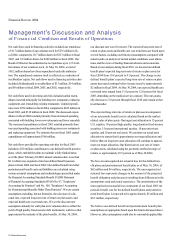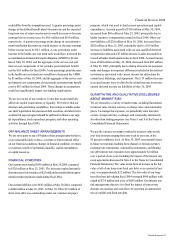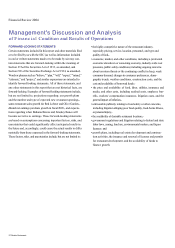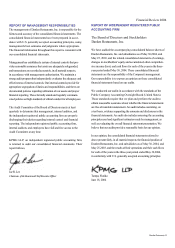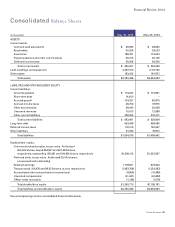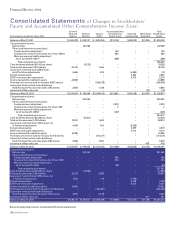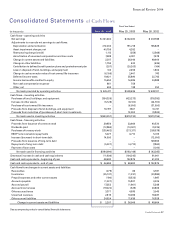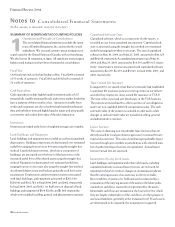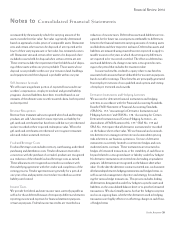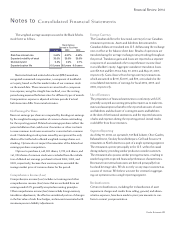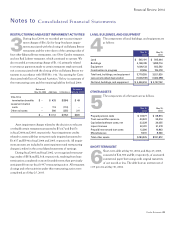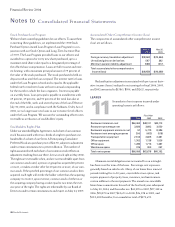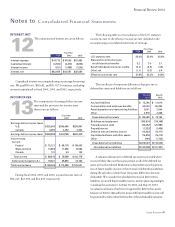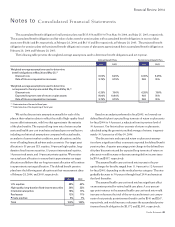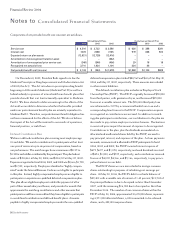Red Lobster 2004 Annual Report Download - page 40
Download and view the complete annual report
Please find page 40 of the 2004 Red Lobster annual report below. You can navigate through the pages in the report by either clicking on the pages listed below, or by using the keyword search tool below to find specific information within the annual report.
40
Changes in the fair value of derivatives that are highly effec-
tive and that are designated and qualify as cash flow hedges
are recorded in other comprehensive income until earnings are
affected by the variability in cash flows of the designated hedged
item. Where applicable, we discontinue hedge accounting pro-
spectively when it is determined that the derivative is no longer
effective in offsetting changes in the cash flows of the hedged
item or the derivative is terminated. Any changes in the fair value
of a derivative where hedge accounting has been discontinued or
is ineffective are recognized immediately in earnings. Cash flows
related to derivatives are included in operating activities.
Pre-Opening Expenses
Non-capital expenditures associated with opening new restaurants
are expensed as incurred.
Advertising
Production costs of commercials are charged to operations in the
fiscal period the advertising is first aired. The costs of programming
and other advertising, promotion, and marketing programs are
charged to operations in the fiscal period incurred. Advertising
expense amounted to $210,989, $200,020, and $184,163, in fiscal
2004, 2003, and 2002, respectively.
Stock-Based Compensation
SFAS No. 123, “Accounting for Stock-Based Compensation,”
encourages the use of a fair-value method of accounting for stock-
based awards under which the fair value of stock options is deter-
mined on the date of grant and expensed over the vesting period.
As allowed by SFAS No. 123, we have elected to account for our
stock-based compensation plans under an intrinsic value method
that requires compensation expense to be recorded only if, on
the date of grant, the current market price of our common stock
exceeds the exercise price the employee must pay for the stock.
Our policy is to grant stock options at the fair market value of our
underlying stock on the date of grant. Accordingly, no compensa-
tion expense has been recognized for stock options granted under
any of our stock plans because the exercise price of all options
granted was equal to the current market value of our stock on the
grant date. In December 2002, the FASB issued SFAS No. 148,
“Accounting for Stock-Based Compensation.” SFAS No. 148 pro-
vides alternative methods of transition for voluntary change to the
fair value method of accounting for stock-based compensation.
In addition, SFAS No. 148 requires more prominent disclosures
in both annual and interim financial statements about the method
of accounting for stock-based compensation and the effect of the
method used on reported results.
Had we determined compensation expense for our stock options
based on the fair value at the grant date as prescribed under SFAS
No. 123, our net earnings and net earnings per share would have
been reduced to the pro forma amounts indicated below:
FiscalYear
2004 2003 2002
Netearnings,asreported $231,462$232,260 $237,788
Add:Stock-basedcompensation
expenseincludedinreported
netearnings,netofrelated
taxeffects 3,158 2,642 2,695
Deduct:Totalstock-based
compensationexpense
determinedunderfairvalue
basedmethodforallawards,
netofrelatedtaxeffects (17,980) (19,801) (18,386)
Proforma $216,640 $215,101 $222,097
Basicnetearningspershare
Asreported $1.42 $1.36$1.36
Proforma $1.33 $1.26 $1.27
Dilutednetearningspershare
Asreported $1.36 $1.31$1.30
Proforma $1.28 $1.22$1.21
To determine pro forma net earnings, reported net earnings
have been adjusted for compensation expense associated with stock
options granted that are expected to eventually vest. The preceding
pro forma results were determined using the Black Scholes option-
pricing model, which values options based on the stock price at the
grant date, the expected life of the option, the estimated volatility
of the stock, expected dividend payments, and the risk-free inter-
est rate over the expected life of the option. The dividend yield
was calculated by dividing the current annualized dividend by the
option exercise price for each grant. The expected volatility was
determined considering stock prices for the fiscal year the grant
occurred and prior fiscal years, as well as considering industry
volatility data. The risk-free interest rate was the rate available on
zero coupon U.S. government obligations with a term equal to the
expected life of each grant. The expected life of the option was esti-
mated based on the exercise history from previous grants.
Notesto
Consolidated Financial Statements
Financial Review 2004


